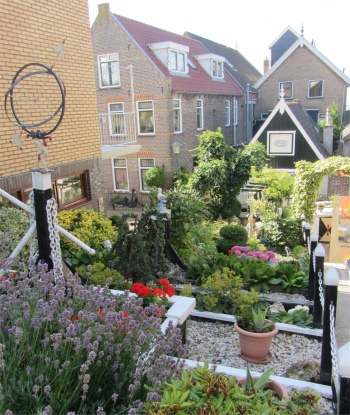On the north side of the hill, a grass covered dyke stretched directly north for about 10km, an indication that much of Flevoland was reclaimed. This dyke was the only protection the low lying polder, with its modern housing estates, had from the Ijsselmeer. Rex had noticed that the water drop from the Ijsselmeer to an inland canal at the lock by the marina was about 6m!
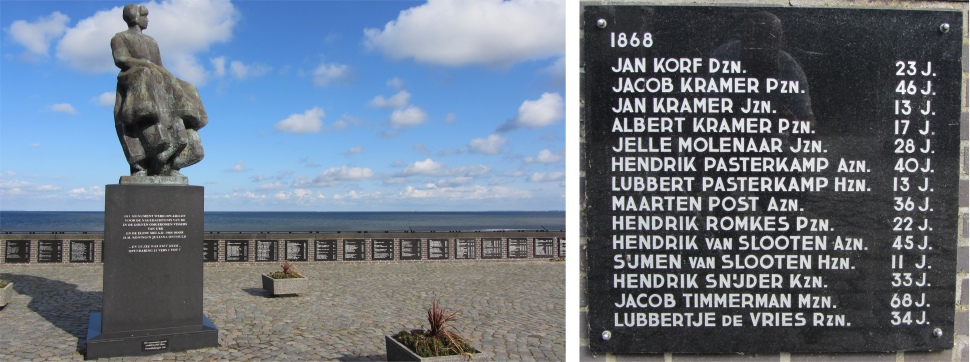
Vissersmonument - Notice the Three Groups of Fathers and Sons Lost in 1868
|
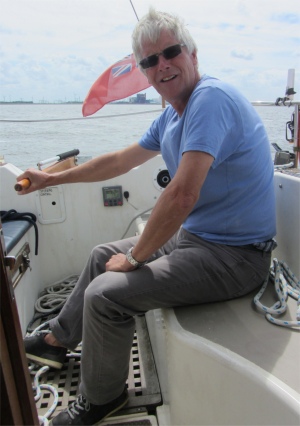
Farewell Urk
|
A few paces from the western most point, the Vissersmonument (Fisherman's Monument) stood, where a plaque commemorates local fishermen lost at sea, and a lonely statue of a woman in a billowing dress gazes seaward, presumably awaiting the return of her man and sons. 33 marble tablets around the perimeter list the Urk seafarers who never returned - name, age and ship's ID number, with new names still being added. There are 353 names carved into the stones dating from 1865, several perished in the stormy waves of the North Sea. Many were grouped as fathers with their sons, the latter as young as 10 years old.
The lighthouse that stood on the summit of the hill still functioned, but sadly today maintenance work was being carried out, rendering it closed to the public.
Winding our way back along the harbour front, we stopped to watch a traditional wooden vessel being drawn up a slipway. Much shouting and hollering took place to ensure it was properly lined up before the winch started. As soon as it was safely secured up the slipway, no time was wasted in getting a high pressure hose directed onto the bottom of the craft to remove the barnacles.
We returned to
Duonita, cast off, and were soon beating down the Ijsselmeer to Lelystad, a straight forward sail, that is until a small cruiser boat refused to alter his speedy course, forcing us to come about to avoid a collision. We were none too pleased with the skipper and a few choice words were muttered. We were picking up barge traffic now, most of which came from or to the Ketelmeer just to the south of Urk, plus an increase in yachts, all heading towards the locks at Lelystad.
The Markermeer Dam slowly came into focus, a long dam crossing from Lelystad to Enkhuizen, with a major roadway running along the top of it. At the Enkhuizen end, a black cloud of smoke steadily climbed to the heavens, perhaps a large fire somewhere in North Holland. Terns wheeled above us, taking sudden swooping dives into the mere to secure another fish. The large nuclear power station of Flevo Centrale slowly slipped behind us, but the giant crane in Urk still stood proud in the distance, and the seemingly never ending coastal wind turbines never left us. It was a lovely sail, perhaps a Force 4, and the requirement to change tack several times gave the journey a refreshing variety.

Hello Lelystad, Dominated by the Tall TV and Telecomms Tower
|
Several marinas exist at Lelystad, and we decided on the one nearest the locks. We were guided to a visitor's pontoon, and within a short space of time the harbour master was helping us tie up exactly where he wanted us on the pontoon.
Once secure, I went off to pay the man, whose first priority seemed to be to hoist the UK ensign up his flagpole. We now joined the Dutch and German flags flapping above the facilities area.
"How long is your boat?" asked the man. "8.8m length and 3.3m breadth," I replied. "That will be 12.15 euros," the fellow informed me. "Toilets, showers, WiFi and electricity are all free," he added. "Free beer too?" I asked, tongue in cheek. He and another customer waiting behind me fell into fits of laughter. Was it something I said I wondered as I left his office, the peals of laughter still echoing down the stairwell.
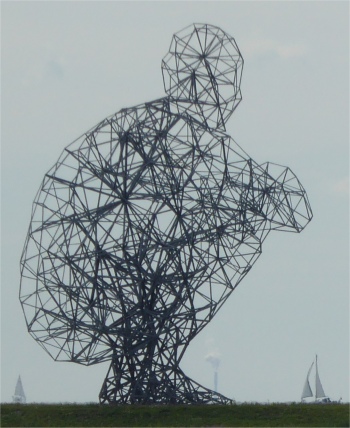
Huge Wire Sculpture at Lelystad
|
All sorted out, we headed off towards Lelystad, passing a very tall T.V. and telecommunications tower on the way. Passing by the locks on the way, we took a small diversion to watch the traffic passing through. A yacht was just tying up on the far side on one of the two large locks. Then it was dwarfed by an enormous barge that glided in alongside the yacht and shuddered to a halt a short distance from the exit gate. Road traffic zoomed across the lifting bridge that passed over the lock, the link between Flevoland, the Markermeer Dam and on to North Holland.
A woman clambered down a ladder from the wheelhouse of the barge. "Are you the chief engineer?" I jokingly asked her. She giggled back, and a voice belonging to the captain boomed out of the depths of the wheelhouse, "No, we are only the servants," and out popped a head displaying a grin from ear to ear. While they were waiting, we had a lengthy chat with the crew of two, who were delivering a load of steel coils to Amsterdam. "Do you like Amsterdam?" I asked. "No!" was the joint assured answer. I learned they came from Arnhem, which they much preferred to the city. The words, "A Bridge Too Far" struck a chord with them. We discussed the imminent storm due in on Saturday, and Rex enquired about the delivery over the Ijsselmeer during foul weather. The skipper thought for a while, and gave his considered answer, "It is only a problem when the wind comes in from the south-west. Then the water can become quite rough. Sometimes the wind can reach Force 6, then we only venture out depending upon the load we are carrying. The steel coils we are carrying now weigh twenty tons each, and they pose a real problem in rough seas. If they shifted in the hold we would be in grave difficulties. On the other hand, cattle fodder is quite a stable cargo."
The exit lock gate opened and off he hopped to extricate the barge out of the lock. The yacht had to hang about a while until the road bridge opened.
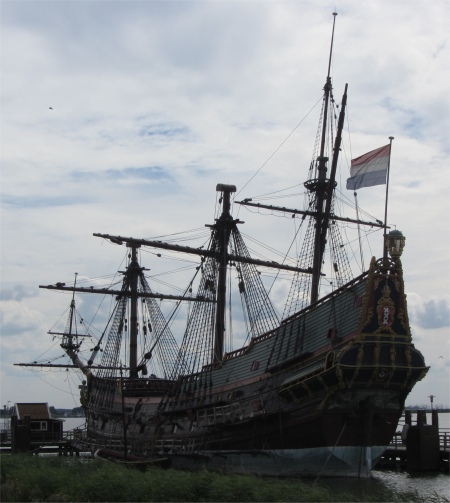
Batavia
|
We carried on down towards the Bataviawerf, home to a replica of a 17th century Dutch merchant frigate, the
Batavia, which took 10 years to reconstruct. The original was a 17th century
Titanic - big, expensive and supposedly unsinkable. True to comparison, the
Batavia, filled to the brim with cannon and goods for the colonies, went down in 1629 on its maiden voyage off the west coast of Australia. The replica, however, redeemed its predecessor in 2000 by sailing around the Pacific. Sadly we only had time to visit one museum, and the Batavia drew the short straw.
The Batavia Stad Fashion Outlet, in the guise of a mock fort, stood next to the Bataviawerf. It is a huge factory outlet centre, the first fashion outlet centre in the Netherlands. Neither I nor Rex had any interest in visiting it, though I'm sure Meryl could have spent a couple of days there.
Just past the Bataviawerf was the Nieuw Land Erfgoedcentrum (New Land Heritage Centre), a museum, archive and research centre offering information regarding Flevoland, the Netherlands' newest province. Almost half of the Netherlands was created by Brobdingnagian land reclamations, so the New Land Heritage Centre features exhibits about the reclamation process and, of course, the polder. We also learned about the prehistoric Swifterbant people, hunters and gatherers that used the art of pottery in their everyday life. This area around Flevoland is also known as the biggest ship cemetery on dry land. The effects of how time changed very old ships, the captains and pirates of such ships were all features of the museum. An exhibition showed a great number of photographs, maps, drawings, archaeological research and documents that provided all the information needed to understand the historical evolution and importance of land reclamation, water and polder. The Centre was an attraction for all ages, but was mostly aimed at kids. Children could conduct a lot of experiments and play different games that showed them the biggest challenge in the Netherlands - the water management. Rex was in his element, enjoying a second childhood, playing with locks and other experiments, indeed he was still playing as happy as a sand boy when we were evicted at closing time.
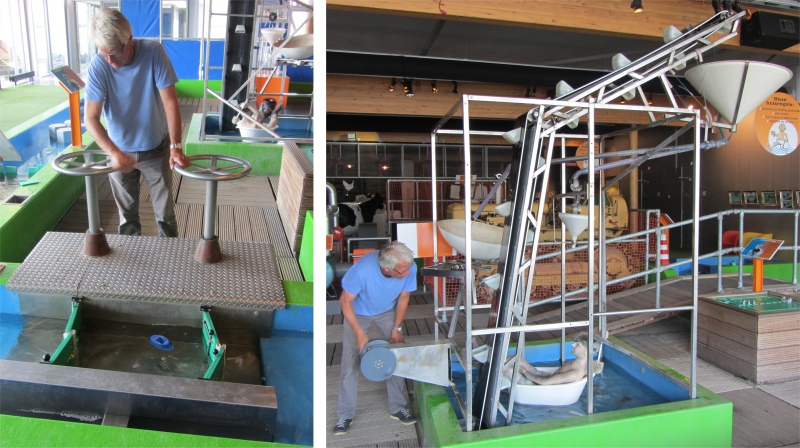
Rex at Play in the New Land Heritage Centre
|
Lelystad was intended to be the main city of the Ijsselmeer polders. Therefore, the city was named after the founder of the Zuiderzee project, engineer Cornelis Lely (1854 - 1929). Cornelis Lely was a Dutch engineer, an expert of hydraulic engineering as well as a minister, governor and politician. In 1891 Lely developed a plan for the closure of the then Zuiderzee. In 1932 the Zuiderzee indeed was closed by means of the Afsluitdijk (closing dyke) and the Ijsselmeer was created.
Construction of Lelystad actually began before the Eastern part of Flevoland was drained. In 1950, Perceel P (allotment P) was created, a working island in the midst of the Ijsselmeer. The workers inhabiting that island had to create a building pit for the Wortman water pump station which was then used for draining the eastern part of Flevoland. Perceel P, the oldest part of Lelystad, today is called Lelystad Haven.
Construction of the remaining part of the city began in 1965. And the first inhabitants arrived in September 1967. However, development of Lelystad proceeded slowly, mainly due to poor connections to the mainland which persisted for years. Another problem was a decision making process regarding the Markerwaard polder which took years to produce results. The plan was to let this polder become the urban hinterland of Lelystad. It was in the mid-90s when a major course change took place at Lelystad. From that point on, renowned architects were attracted and involved to give the city its own identity and instil confidence. Old residence quarters were restructured and the city centre was completely renewed. Also, the coastal area of Lelystad got a new impulse due to construction of high quality residential areas and new recreational facilities.
